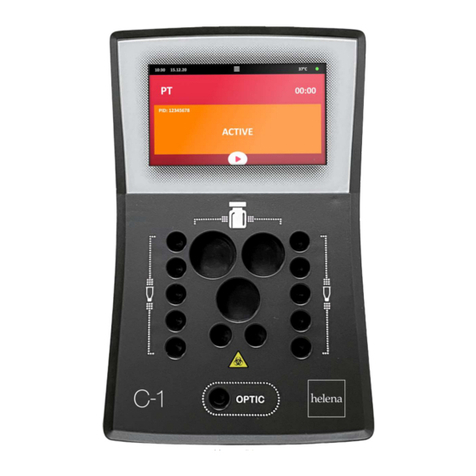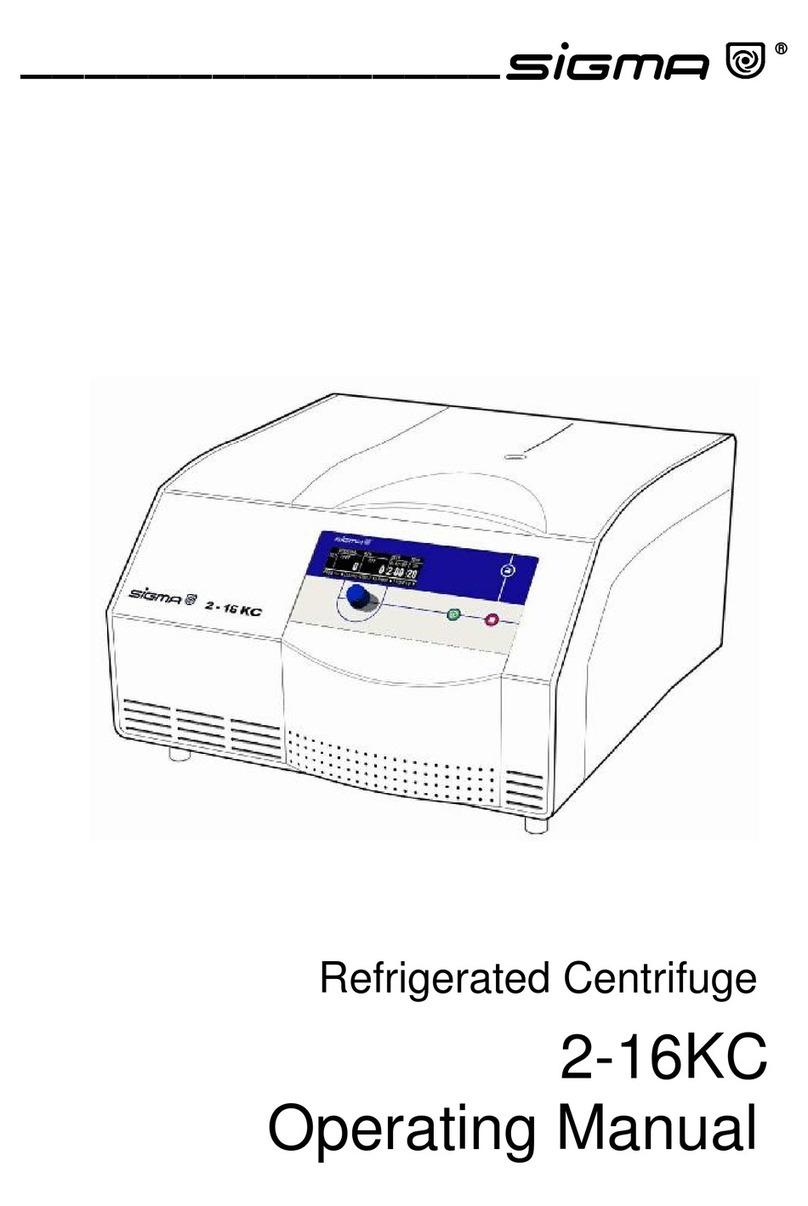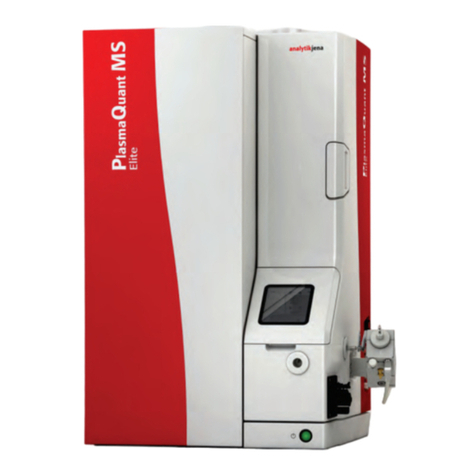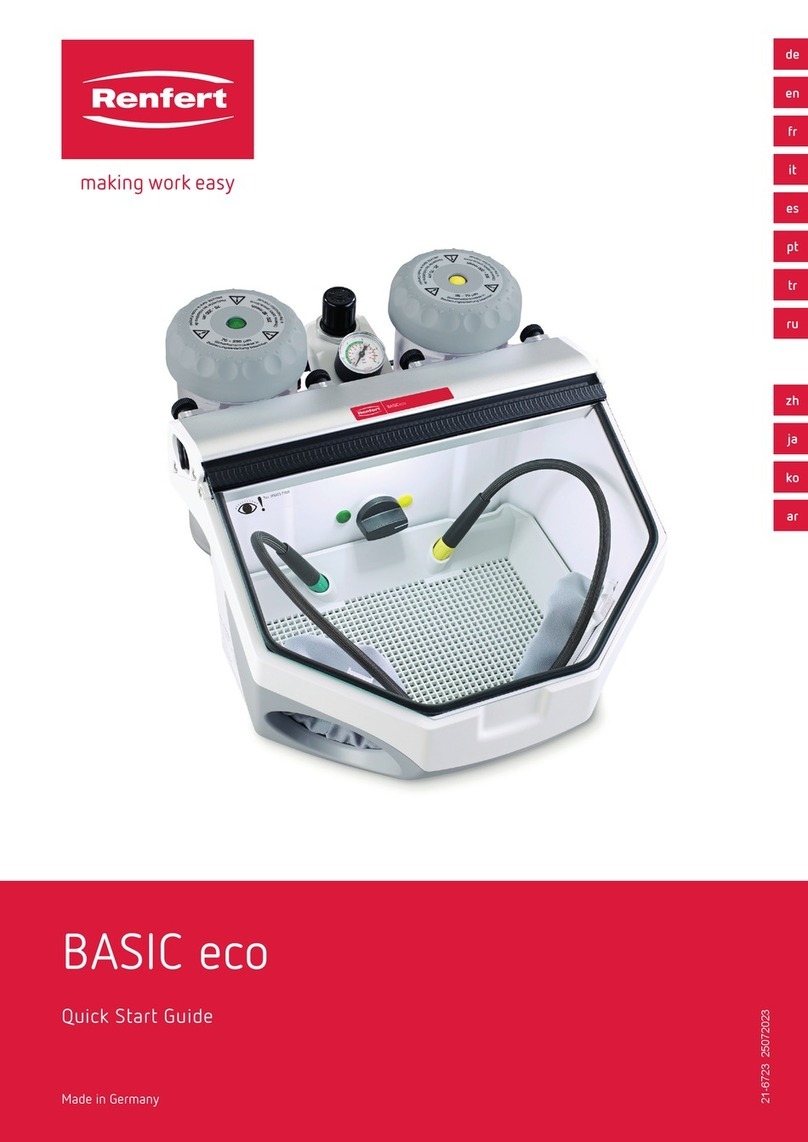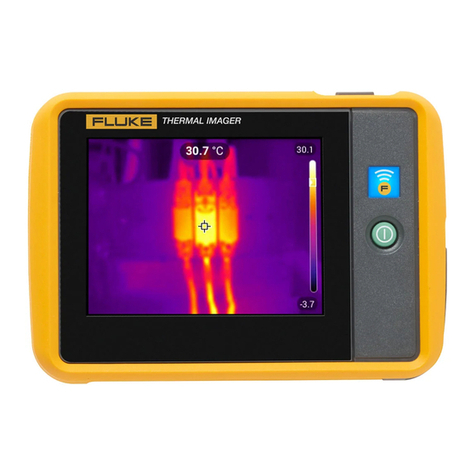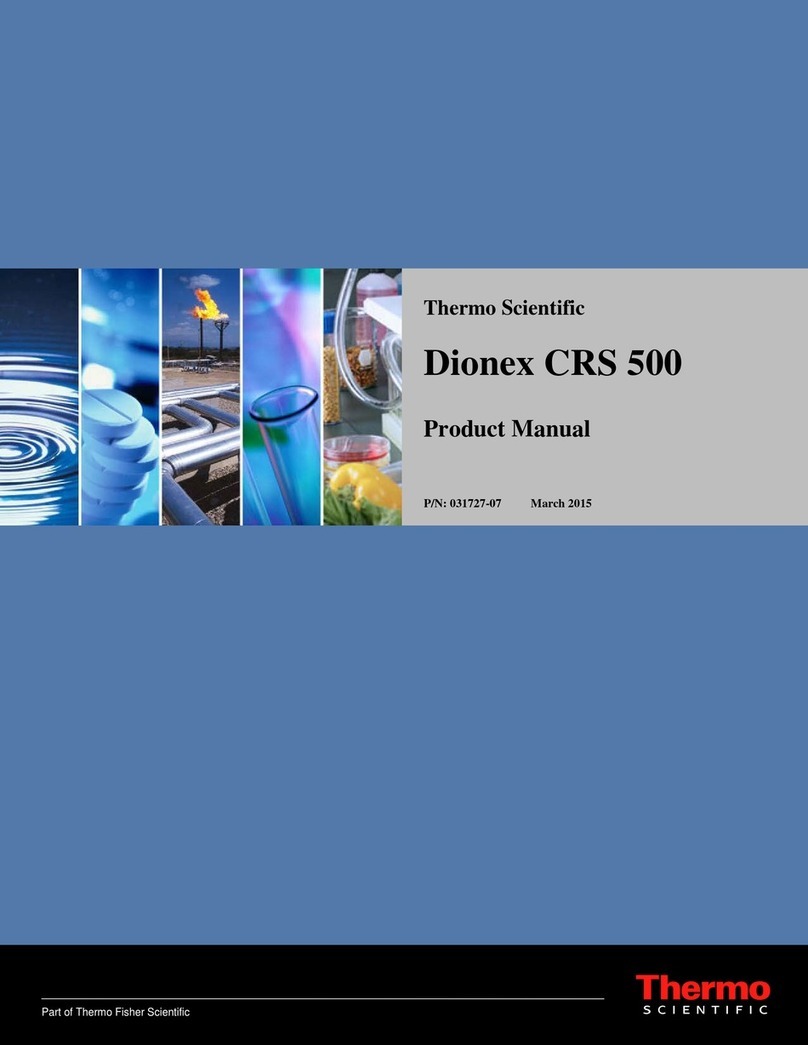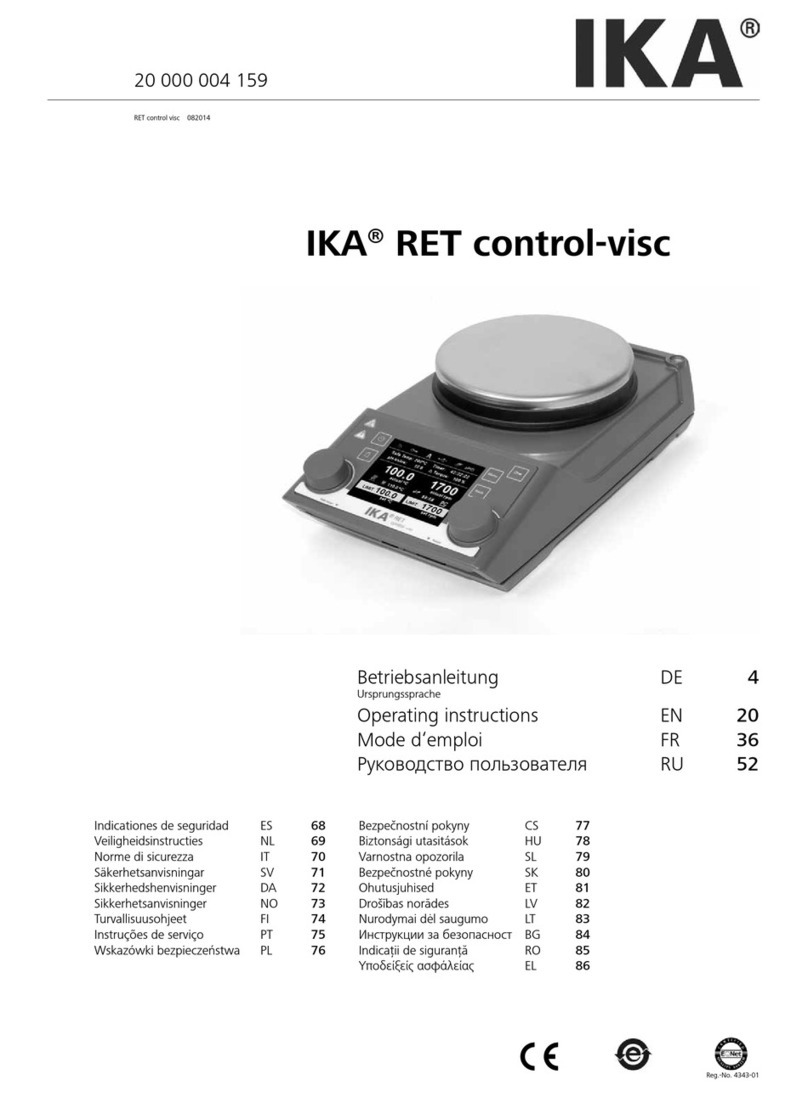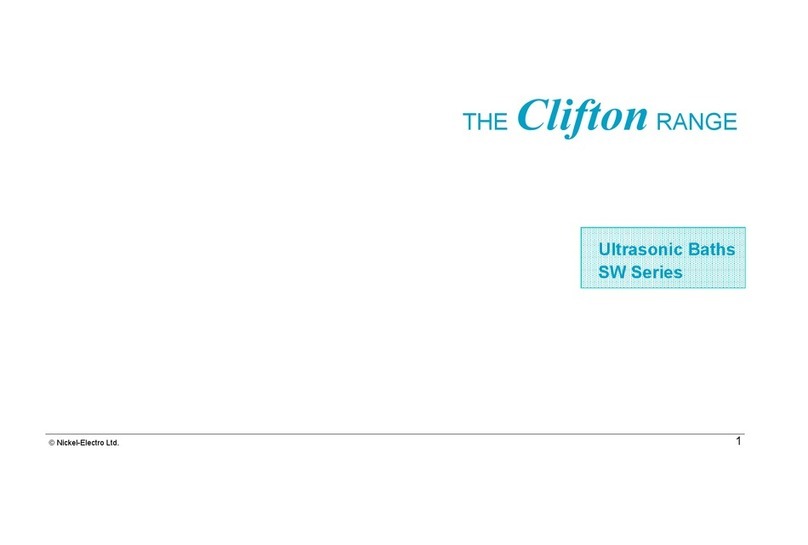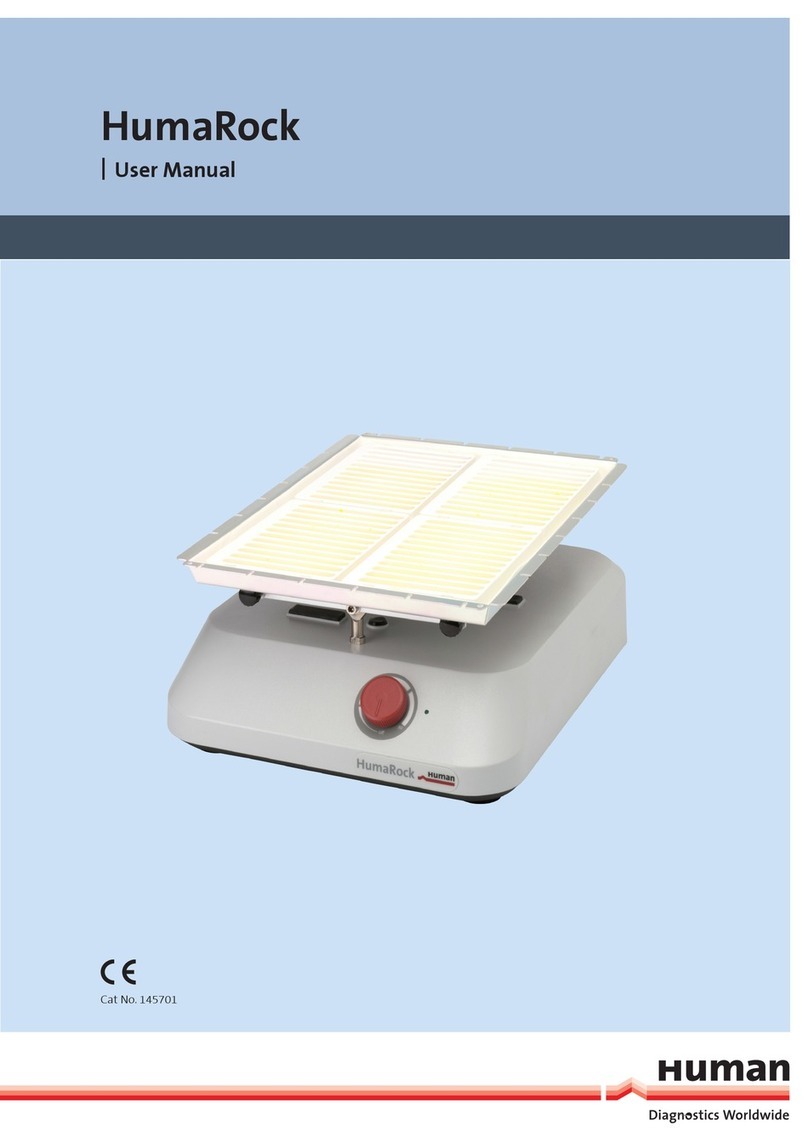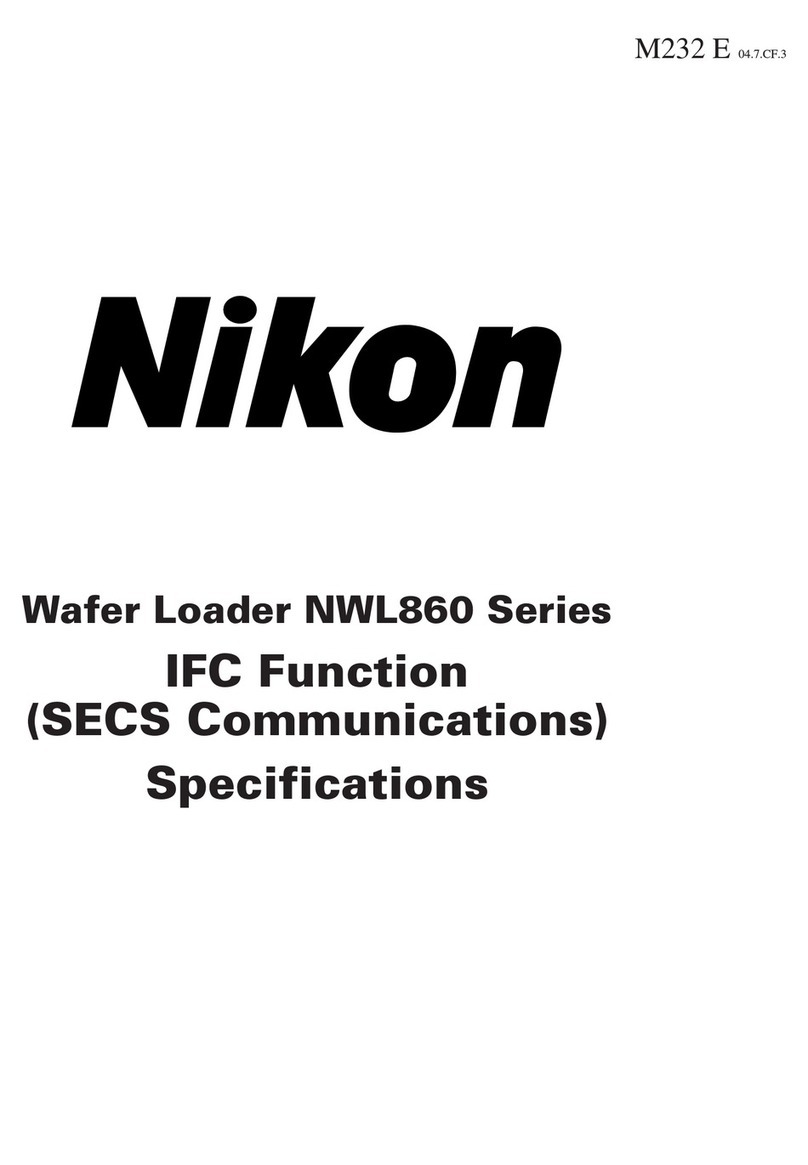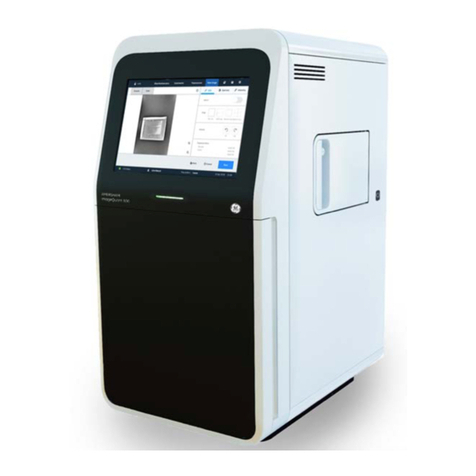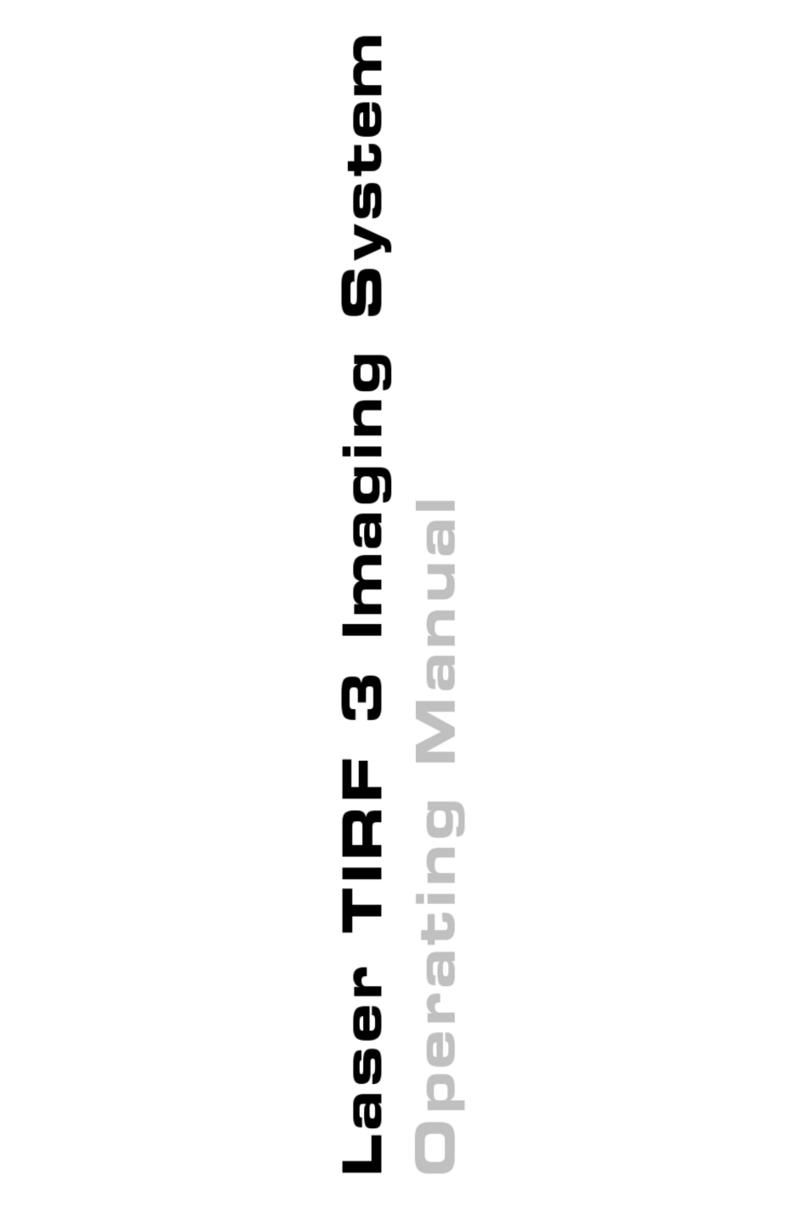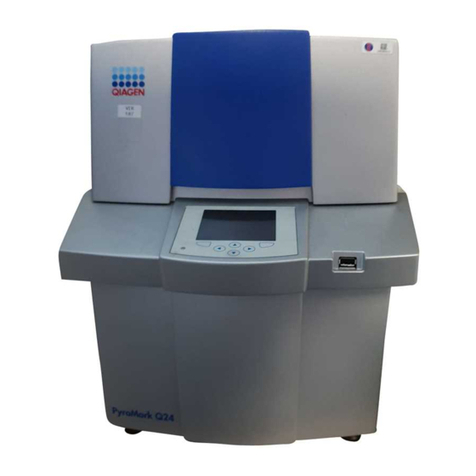helena BioSciences SAS-1 Immunofix User manual

Instructions For Use
SAS-1 Immunofix
Cat. No. 200300
SAS-1 Immunofix
Fiche technique
Réf. 200300
SAS-1 Immunofixation
Anleitung
Kat. Nr. 200300
SAS-1 Immunofissazione
Istruzioni per l’uso
Cod. 200300
SAS-1 Inmunofijación
Instrucciones de uso
Node catálogo 200300
helena
www.helena-biosciences.com
BioSciences
Europe
Contents
English 1
Français 9
Deutsch 17
Italiano 26
Español 35


INTENDED PURPOSE
The SAS-1 IFE kit is intended for the separation and identification of monoclonal gammopathies by
agarose gel electrophoresis.
Immunofixation electrophoresis (IFE) is a two stage procedure using high resolution agarose
electrophoresis in the first stage, and immunoprecipitation in the second phase.
The greatest demand for IFE is in the clinical laboratory, where it is used primarily for the detection of
monoclonal gammopathies. A monoclonal gammopathy is a primary disease state in which a single
clone of plasma cells produce elevated levels of an immunoglobulin of a single class and type.
Such immunoglobulins are referred to as monoclonal proteins, M-proteins or paraproteins.
Their presence may be of a benign nature or of uncertain significance. In some cases, they are
indicative of a malignancy, such as multiple myeloma or Waldenström's macroglobulinaemia.
Differentiation must be made between polyclonal and monoclonal gammopathies, as polyclonal
gammopathies are a secondary disease state due to clinical disorders such as chronic liver disease,
collagen disorders, rheumatoid arthritis and chronic infection.
Urinary proteins are derived primarily from plasma proteins that filter through the kidney.
The appearance of abnormal plasma proteins in the urine is of great value in evaluating renal function.
The appropriate study of proteinuria should include quantitative and qualitative assessment of the type
and amount of proteins excreted1-5. The combination of electrophoretic separation of urine proteins,
coupled to the identification of specific protein types by immunoprecipitation allows the differentiation
of several types of proteinuria - Physiological, Glomerular (selective and non-selective), Tubular and
proteinuria associated with Dysglobulinaemias1-5.
Alfonso first described immunofixation in the literature in 19646. Alper and Johnson published a more
practical procedure in 1969, and published a number of studies utilising this technique7-9.
Immunofixation has been used as a procedure for the investigation of immunoglobulins since 197610-11.
The SAS-1 IFE kit separates serum proteins according to charge in an agarose gel. The proteins are
then incubated with monospecific antisera, washed and stained to allow visualization of the
immunoprecipitate for qualitative interpretation.
WARNINGS AND PRECAUTIONS
All reagents are for in-vitro diagnostic use only. Do not ingest or pipette by mouth any kit component.
Wear gloves when handling all kit components. Refer to the product safety data sheet for risk and
safety phrases and disposal information.
COMPOSITION
1. SAS-1 IFE Gel
Contains agarose in a Tris / Barbital buffer with thiomersal and sodium azide as preservative.
The gel is ready for use as packaged.
2. Acid Violet Stain Concentrate
Contains concentrated Acid Violet stain. Dilute the contents of the bottle to 700ml with purified
water. Stir overnight and filter before use. Store in a tightly stoppered bottle.
3. Destain Solution Concentrate
Dilute the contents of Destain A to 1 litre with purified water. Then add the contents of Destain
B and add a further 1 litre of purified water, slowly.
1
SAS-1 IMMUNOFIX
English

4. Wash Solution
Contains 100ml of concentrated Wash Solution. Dilute 20ml to 1 litre with saline solution.
5. Sample Diluent
Contains Tris / Barbital buffer with bromophenol blue and sodium azide as preservative.
The diluent is ready for use as packaged.
6. SAS-1 IFE Antisera Kit
Contains SP protein fixative (containing acetic acid and sulphosalicylic acid), and monospecific
antisera to human immunoglobulins - IgG, IgA, IgM, Kappa Light Chain (free & bound) and Lambda
Light Chain (free & bound). All antisera contain sodium azide as a preservative. The antisera are
ready for use as packaged.
7. Other Kit Components
Each kit contains Instructions For Use and sufficient Blotters B, C, D, X and Blotter Combs to
complete 10 gels.
STORAGE AND SHELF-LIFE
1. SAS-1 IFE Gel
Gels should be stored at 15...30°C and are stable until the expiry date indicated on the package.
DO NOT REFRIGERATE OR FREEZE. Deterioration of the gel may be indicated by 1) crystalline
appearance indicating the gel has been frozen, 2) cracking and peeling indicating drying of the gel
or 3) visible contamination of the agarose from bacterial or fungal sources.
2. Acid Violet Stain
The stain concentrate should be stored at 15...30°C and is stable until the expiry date indicated on
the label. Diluted stain solution is stable for 6 months at 15...30°C. It is recommended to discard
used stain immediately to prevent depletion of staining capability. Poor staining performance may
indicate deterioration.
3. Destain Solution
The destain concentrate should be stored at 15...30°C and is stable until the expiry date indicated
on the label. Diluted destain solution is stable for 6 months at 15...30°C.
4. Wash Solution
The Wash Solution concentrate should be stored at 15...30°C and is stable until the expiry date
indicated on the label. Diluted wash solution is stable for 6 months at 15...30°C. Cloudiness may
indicate deterioration.
5. Sample Diluent
The Sample Diluent should be stored at 15...30°C and is stable until the expiry date indicated on
the label. Cloudiness may indicate deterioration.
6. SAS-1 IFE Antisera Kit
The antisera kit should be stored at 2...6°C and is stable until the expiry date indicated on the label.
Particulate contamination or cloudiness may indicate deterioration.
2

ITEMS REQUIRED BUT NOT PROVIDED
Cat. No. 210200 Sample Applicator Blades (1 x 10)
Cat. No. 210300 Sample Applicator Blades (5 x 10)
Cat. No. 210100 Disposable sample cups (100)
Cat. No. 5014 Development Weight (2.3kg)
Cat. No. 3100 REP Prep
Drying oven with forced air capable of 60...70°C.
Saline solution (0.85% NaCl)
The following items are not required for standard serum IFE but may be required for further
investigation and Urine IFE investigation:
Cat. No. 220100 Antiserum to Human Urine Total Protein (2ml)
Cat. No. 220200 Antiserum to Human Urine Micro Proteins (2ml)
Cat. No. 220300 Antiserum to Human Urine Macro Proteins (2ml)
Cat. No. 220400 Antiserum to Human GAM Proteins (2ml)
Cat. No. 220700 Antiserum to Human Free & Bound Kappa Light Chain (2ml)
Cat. No. 220800 Antiserum to Human Free & Bound Lambda Light Chain (2ml)
Cat. No. 220500 Antiserum to Human Free Kappa Light Chain (2ml)
Cat. No. 220600 Antiserum to Human Free Lambda Light Chain (2ml)
Cat. No. 220900 Antiserum to Human Urine Pentavalent/Albumin (2ml)
Cat. No. 221000 Antiserum to Human Urine Pentavalent (2ml)
Cat. No. 9249 Antiserum to Human IgD
Cat. No. 9250 Antiserum to Human IgE
Cat. No. 9400 IFE Control Kit
SAMPLE COLLECTION AND PREPARATION
Freshly collected serum is the specimen of choice. Samples can be stored at 15...30°C for up to 4 days,
2...6°C for up to 2 weeks or 6 months at -20°C6.
Urine samples should be applied neat. Serum samples should be diluted according to the following
table using Sample Diluent:
Monoclonal Concentration SP Lane G, A, M, κκ,,λλ
<3g/L 1+2 Neat
3-10g/L 1+2 1+4
10-25g/L 1+2 1+9
25-50g/L 1+2 1+19
STEP BY STEP PROCEDURE
1. Pipette 35µl of the sample into the appropriate well of the SAS-1 sample tray or disposable sample
cups.
ii))SSAASS--11&&SSAASS--11PPlluussuusseerrss::Carefully place the sample tray onto the applicator drawer. Ensure that
the tray is pushed firmly down into position.
iiii))SSAASS--33uusseerrss::Carefully locate the sample tray using the sample base locating pins. Ensure that the
tray is positioned securely.
2. Remove the gel from the packaging and:
ii))SSAASS--11uusseerrss::place the gel in the SAS-1, agarose side up, aligning the positive and negative sides
with the corresponding electrode posts.
3
SAS-1 IMMUNOFIX
English

iiii))SSAASS--11PPlluussuusseerrss::dispense 400µL of REP Prep onto the heat sink. Place the gel onto the heat sink,
agarose side up, aligning the positive and negative sides with the corresponding electrode posts,
taking care to avoid air bubbles under the gel.
iiiiii))SSAASS--33uusseerrss::place the alignment guide onto the pins and dispense 400µL of REP Prep onto the
centre of the chamber. Place the gel into the chamber agarose side up, using the guide, align the
positive and negative sides with the corresponding electrode posts, taking care to avoid air bubbles
under the gel.
3. Blot the surface of the gel with a blotter C, discard the blotter.
4. ii))SSAASS--11uusseerrss::attach the electrodes onto the top side of the electrode posts so that they are in
contact with the gel blocks.
iiii))SSAASS--11PPlluussuusseerrss::(as above). Place the cover over the gel and electrodes and press firmly for 5
seconds to ensure contact.
iiiiii))SSAASS--33uusseer
rss::attach the electrodes onto the the electrode posts so that they are in contact with
the gel blocks.
5. Place 2 applicator blade assemblies in position on the instrument, ((SSAASS--33uusseerrss::sslloottAAaanndd1100)).
6. Perform the Immunofix electrophoresis:
ii))SSAASS--11uusseerrss::80 volts, 20 mins
iiii))SSAASS--11PPlluussuusseerrss::Electrophoresis: 100 volts, 18 mins, 20°C
Incubation Step 1: 8 mins, 37°C (incubate)
Incubation Step 2: 8 mins, 40°C (D blot)
iiiiii))SSAASS--33uusseerrss::
Step Time (mm:ss) Temperature (°C) Voltage Other
Load Sample 00:30 21 Speed 1
Apply Sample 00:30 21 Speed 1*
Electrophoresis 17:00 21 100
Apply antisera 10:00 21
Insert Combs 02:00 21
Blotter D 05:00 40
Dry 08:00 54
* Use Location 2
NNOOTTE
E11::For Serum immunofixation, 1 sample application is required. For Urine immunofixation,
10 sample applications are required. Remove the gel blocks prior to drying.
NNOOTTEE22::Urine and serum samples can be run simultaneously on one gel. However, each
individual row must contain one type of sample only (eg. top row = urine, bottom row = serum).
If a combination of serum and urine are to be used on the same gel, place both blades onto the
SAS-1plus, and remove the ‘serum’ blade after the first load/application. Leave the ‘urine’ blade to
complete the other 9 load/applications.
7. Following electrophoresis, ((SSAASS--11PPlluussuusseerrss::remove the cover), remove the electrodes from the
surface of the gel. ((SSAASS--33uusseerrss::remove the alignment guide). Position the antiserum application
template onto the gel surface. NOTE: The milled antisera channels should be aligned centrally
over the printed box on the gel in which the samples are applied.
8. Apply 2 drops (or 50µL) of Protein Fixative (serum) or Total Antiserum (urine) into the hole of the
SP lane and 2 drops (or 50µL) of the appropriate antiserum into the hole of the immunoglobulin
lanes. Ensure that the fixative and antisera have completely filled the channels.
9. Incubate the gel. ((SSAASS--11uusseerrss::incubate at 15...30°C).
4

10. Following incubation, place a blotter comb into the holes of the antiserum template. Allow 2
minutes for the excess antisera to be absorbed, then remove the blotter combs and the template
from the gel surface.
11. ii))SSAASS--11uusseerrss::Remove the gel blocks using the Gel Block Remover and wash the gel in wash
solution for 5 minutes.
iiii))SSAASS--11PPlluussaannddSSAASS--33uusseerrss::Place a blotter D (smooth side down) onto the surface of the gel,
leave for 10 seconds and remove.
12. ii))SSAASS--11uusseerrss::Place the gel on a blotter D agarose side up and place a blotter B (wetted in wash
solution) onto the surface of the gel followed by two blotter X’s. Press the gel using the
Development Weight for 10 minutes.
iiii))SSAASS--11PPlluussaannddSSAASS--3
3uusseerrss::Place a blotter D (smooth side down) onto the surface of the gel
and replace the antiserum template to hold the blotter flat. Blot the gel.
13. ii))SSAASS--11uusseerrss::Remove the blotters and place the gel in wash solution for 4 minutes with gentle
agitation.
iiii))SSAASS--11PPlluussaannddSSAASS--33uusseerrss::Remove the blotter D.
14. ii))SSAASS--11uusseerrss::Remove the gel from the wash solution and place on a blotter D agarose side up.
Place a blotter B (wetted in wash solution) onto the surface of the gel followed by a blotter D.
Press the gel for 3 minutes.
iiii))SSAASS--11PPlluussaannddSSAASS--33uusseerrss::Remove the gel blocks using the Gel Block Remover. Go to Step
16.
15. ii))SSAASS--11uusseerrss::Remove the blotters.
NOTE: Immediately after use, clean the antisera template with a mild, biocidal detergent.
If possible, scrub the bottom of the template with a toothbrush or small test tube brush. Do not
let the antisera dry on the template. Build up of antisera on the surface of the template will result
in the formation of bubbles during the antisera application step. Dry the antisera template
thoroughly. Water left in the holes will hinder the application of antisera for the next use. Store
the template upside down to increase the air circulation and thus the drying potential of the
applicator.
16. Attach the gel to the staining chamber holder.
17. Select the IFE test program on the staining unit and, following the prompts, Wash, Stain, Destain
and Dry the gel.
a) SAS-2 (Auto-Stainer)
Step Solution Time (mm:ss) Port Temp (°C)
Dry —- 10:00 55
Wash Wash solution 07:00 4
Stain Acid Violet Stain 03:00 5
Destain Destain solution 02:00 2
Dry —- 05:00 65
Wash Wash solution 03:00 4
Wash Wash solution 03:00 4
Dry —- 05:00 65
b) SAS-4 (Auto-Stainer)
Step Time (mm:ss) Temp (°°CC) Other
Wash 00:03 Recirculate ON
Wash 10:00 Recirculate ON
5
SAS-1 IMMUNOFIX
English

Stain 04:00 Recirculate ON
Destain 02:00 Recirculate ON
Destain 02:00 Recirculate ON
Dry 12:00 63
c) Manual
Follow the sequence listed for the SAS-2 staining unit, using a staining bath for the Stain, Destain
and Wash steps, and a Drying Oven with forced air at 60...70°C for the Dry steps.
18. At the end of the staining cycle, remove the gel from the staining chamber. The gel is now ready
for examination.
INTERPRETATION OF RESULTS
The majority of monoclonal proteins migrate in the cathodic, gamma region of the protein pattern,
but due to their abnormal nature, they may migrate anywhere within the globulin region on protein
electrophoresis. The monoclonal protein band on the immunofixation pattern will occupy the same
position and shape as the abnormal band on the serum protein pattern. The abnormal protein is
identified by the antiserum type it reacts with.
When low concentrations of abnormal protein are present, the abnormal band may appear as a band
within the normal polyclonal immunoglobulin. A band can also be seen within a polyclonal background
when there is a large polyclonal immunoglobulin presence also.
The publication 'Immunofixation for the Identification of Monoclonal Gammopathies' is available from
Helena BioSciences on request.
Urine Immunofixation:
Type of Proteinuria Bands Observed On Gel Proteins Present
Normal urine Small albumin band albumin
Glomerular Albumin, alpha-1, albumin, alpha-1
beta, gamma antitrypsin, transferrin,
gamma globulins
Tubular alpha-1, alpha-2, beta Retinol Binding Protein,
beta2-microglobulin,
alpha-2 microglobulin.
Overflow gamma or variable immunoglobulins,
free light chains
LIMITATIONS
1. Antigen Excess
Antigen excess will occur if there is not a slight antibody excess or antigen / antibody equivalence
at the site of precipitation. Antigen excess in IFE is usually due to an excess of the immunoglobulin
in the patient sample. Antigen excess is characterised by prozoning (unstained areas in the centre
of the immunofixed protein band, with staining around the edges). A higher dilution of the sample
should be used in this event to optimise the immunoglobulin concentration.
2. Non-Specific Precipitation in All Immunoglobulin Lanes
Occasionally a completed IFE plate exhibits a precipitate band in the same position in every pattern
across the plate. This may result from:
a) IgM monoclonal immunoglobulins.
6

IgM monoclonal proteins can adhere to the gel matrix. A band will appear in all 5 antiserum lanes
of the gel. However, where the band reacts with a specific antiserum for the heavy chain and light
chain, there will be an increase in size and staining intensity of the band, allowing the
immunoglobulin type to be identified. Additional dilution of the sample will improve the
discrimination between the IgM-antibody reaction and the non-specific staining of precipitated IgM
protein in other lanes, simplifying the diagnosis.
b) High Titres of RF or Immune Complexes.
Samples with high titres of Rheumatoid Factor or other immune complexes may show a prepitate
band at the sample application point. Reducing the sample with DTT or β-2-mercaptoethanol can
eliminate this non-specific reaction (Mix 190µL of diluted serum to 10µL of 1% (w/v) DTT in
0.85% saline solution or mix 100µL of serum with 10µL of a 1:10 dilution of β-2-mercaptoethanol
in water. Perform the IFE as usual. Note: Always work in a fume hood when using
β-2-mercaptoethanol).
c) Fibrinogen.
Fibrinogen, if present in the sample, will show as a discrete band in all lanes of the immunofixation
pattern. Fibrinogen is present in plasma, and sometimes in the serum of patients on anticoagulant
therapy.
3. Reaction With Kappa or Lambda Light Chain Antisera but No Reaction with IgG, IgA or
IgM Heavy Chain Antisera.
Samples showing this pattern may either have a free light chain monoclonal gammopathy or they
may have an IgD or IgE monoclonal protein. In this situation, the IFE should be repeated,
substituting IgD and IgE antisera for two of the other heavy chain antisera. Failure to obtain a
reaction with IgD or IgE antisera would be indicative of free light chain disease.
4. Band In Gamma Region Showing No Reactivity With IFE Antisera.
C Reactive Protein (CRP) may be detected in patients with acute inflammatory response12-13.
CRP appears as a narrow band at the cathodic end of the serum protein pattern. Elevated Alpha1-
Antitrypsin and Haptoglobin are supportive evidence for CRP. Patients with a CRP band will
probably have an elevated level when assayed for CRP. A narrow band on the point of sample
application can sometimes be seen which can be caused by chylomicrons in the serum or
precipitated protein in samples which have been stored frozen.
5. Non-Reactivity With Kappa and Lambda Antisera
Occasionally a sample will have a reaction with a heavy chain antiserum but no light chain reaction
is obvious. In this situation, the following need to be ruled out - a) Heavy chain disease, b) Very
high concentrations of light chains, leading to antigen excess, c) Low concentrations of light chains,
d) Atypical light chain molecule that does not react with the antiserum, e) Light Chains with
'hidden' light chain determinants (as sometimes seen with IgA and IgD). To obtain definitive
results, testing may include a) A higher or lower dilution of the sample to optimise the antibody /
antigen equivalence, b) Antisera from more than one manufacturer to aid in the identification of
atypical immunoglobulins, and c) Treat the sample with β-2-mercaptoethanol to 'reveal' the light
chains.
PERFORMANCE CHARACTERISTICS
A series of samples were tested and compared to another commercially available test kit - both kits
showed equivalent results.
7
SAS-1 IMMUNOFIX
English

QUALITY CONTROL
Helena Biosciences IFE Control Kit (Cat. No. 9400) can be used to confirm the presence of
monoclonal banding in all antisera lanes.
Helena Biosciences Kemtrol Abnormal Serum Control (Cat. No. 7025) can be diluted 1 in 100 and
used as a positive control for Urine IFE.
BIBLIOGRAPHY
1. Fauchier, P. and Catalan, F. ‘Interpretive Guide to Clinical Electrophoresis’ Alfred Fournier
Institute, Paris, France, 1988.
2. Killingsworth, L.M., Cooney, S.K. and Tyllia, M.M. ‘Finding Clues to Disease in Urine’ Diagnostic
Medicine, 1980 ; May/June : 69-75.
3. Umbreit, A. and Wiedemann, G. ‘Determination of Urinary Protein Fractions. A Comparison
With Different Electrophoretic Methods and Quantitatively Determined Protein Concentrations’
Clin. Chim. Acta., 2000; 297 : 163-172.
4. Wiedemann, G. and Umbreit, A. ‘Determination of Urinary Protein Fractions by Different
Electrophoretic Methods’, Clin. Lab.; 1999, 45 : 257-262.
5. Wong, W.K., Wieringa, G.E., Stec, Z., Russell, J., Cooke, S., Keevil, B.G. and Lockhart, S. ‘A
Comparison of Three Procedures for the Detection of Bence-Jones Proteinuria’ Ann. Clin.
Biochem., 1997, 34 : 371-374.
6. Afonso, E., ‘Quantitation Immunoelectrophoresis of Serum Proteins’, Clin. Chim. Acta., 1964; 10
: 114-122.
7. Alper, C.A and Johnson, A.M., ‘Immunofixation Electrophoresis: A Technique for the Study of
Protein Polymorphism’, Vox. Sang., 1969; 17 : 445-452.
8. Alper, C.A.,’Genetic Polymorphism of Complement Components as a Probe of Structure and
Function’, Progress in Immunology. First International Congress of Immunology. 1971 : 609-624,
Academic Press, New York.
9. Johnson, A.M., ‘Genetic Typing of Alpha(1)-Antitrypsin in Immunofixation Electrophoresis.
Identification of Subtypes of Pi M.’, J. Lab. Clin. Med., 1976; 87 : 152-163.
10. Cawley, L.P., Minard, B.J, Tourtellotte, W.W., Ma, B.I. and Chelle, C., ‘Immunofixation
Electrophoretic Technique Applied to Identification of Proteins in Serum and Cerebrospinal Fluid’,
Clin. Chem., 1976; 22 : 1262-1268.
11. Ritchie, R.F and Smith, R. ‘Immunofixation III, Application to the Study of Monoclonal Proteins’,
Clin. Chem., 1976; 22 : 1982-1985.
12. Jeppsson, J.O., Laurell, C.B. and Franzen, B., ‘Agarose Gel Electrophoresis’, Clin. Chem., 1979;
25 (4) : 629-638.
13. Killingsworth, L.M., Cooney, S.K. and Tyllia, M.M., ‘Protein Analysis’, Diagnostic Medicine, 1980;
Jan/Feb : 3-15.
8

UTILISATION
Le kit SAS-1 IFE est utilisé pour la séparation et l'identification des gammapathies monoclonales par
électrophorèse en gel d'agarose.
L'immunofixation (IFE) est une procédure en deux étapes utilisant l'électrophorèse haute résolution en
gel d'agarose dans en premier temps puis l'immunoprécipitation dans un deuxième temps.
C'est en biologie médicale que l'on utilise le plus fréquemment l'IFE pour la détection des
gammapathies monoclonales. Une gammapathie monoclonale est un état primaire de maladie dans
laquelle un seul clone de cellule plasmatique produit en quantité élevée une immunoglobuline d'une
seule classe et d'un seul type. Ces immunoglobulines sont appelées protéines monoclonales,
protéines-M ou paraprotéines. Leur présence peut être de nature bénine ou de signification incertaine.
Dans certains cas, elles révèlent une malignité comme les myèlomes multiples ou Waldenström.
Une différence doit être faite entre gammapathie polyclonale ou monoclonale, la gammapathie
polyclonale étant le stade secondaire de maladie due à un désordre clinique comme l'affection
chronique hépatique, les désordres du collagène, les rhumatismes articulaires et les infections
chroniques.
Les protéines urinaires sont principalement dérivées de la filtration des protéines plasmatiques par le
rein. L'apparition de protéines plasmatiques anormales dans les urines est d'une grande valeur dans
l'évaluation de la fonction rénale. L'étude de la protéinurie doit inclure l'évaluation qualitative et
quantitative du type et de la quantité des protéines excrétées1-5. La combinaison de l'électrophorèse
urinaire, couplée à l'identification spécifique du type des protéines par immunoprécipitation, permet la
différentiation de plusieurs types de protéinurie - Physiologique, Glomérulaire (sélective et non-
sélective), Tubulaire et protéinurie associée à une Dysglobulinémie1-5.
Alfonso fut le premier a décrire l'immunofixation dans la littérature en 19646. Alper et Johnson
publièrent ensuite une procédure plus simple en 1969, puis de nombreuses études utilisant cette
technique7-9. L'immunofixation est utilisée comme procédure d'investigation des immunoglobulines
depuis 197610-11. Le kit SAS-1 IFE sépare les protéines sériques selon leur charge en gel d'agarose. Les
protéines sont ensuite mises en contact avec un antisérum monospécifique, lavées et colorées pour
permettre la visualisation de l'immunoprécipité en vue d'une interprétation qualitative.
PRECAUTIONS
Tous les réactifs sont à usage diagnostic in-vitro uniquement. Ne pas ingérer ou pipeter à la bouche
aucun composant. Porter des gants pour la manipulation de tous les composants. Se reporter aux
fiches de sécurité des composants du kit pour la manipulation et l'élimination.
COMPOSITION
1. Plaque SAS-1 IFE
Contient de l'agarose dans un tampon Tris / barbital additionné de thimérosal et d'azide de sodium
comme conservateur. Le gel est prêt à l'emploi.
2. Colorant Acide Violet
Contient du colorant acide violet concentré. Dissoudre le contenu du bouteille dans 700ml d'eau
distillée, laisser sous agitation toute une nuit. Filtrer avant utilisation. Conserver en bouteille
hermétiquement fermée.
9
SAS-1 IMMUNOFIX
Fran
ç
ais

3. Solution décolorante
Diluer le contenu de décolorant A avec 1 litre d’eau distillée. Ajouter ensuite le contenu de
décolorant B puis, lentement, 1 autres litre d’eau distillée.
4 Solution de lavage
Contient 100ml de solution de lavage concentrée. Diluer 20ml dans 1 litres de solution saline.
5. Solution diluant échantillon
Contient de tampon Tris / Babital additionné de bleu de bromophénol et d'azide de sodium
comme conservateur. Le diluant est prêt à l'emploi.
6. SAS-1 IFE Antiséra kit
Contient un bouteille de solution fixative SP contenant de l'acide acétique et de l'acide
sulfosalicylique, et des antiséra monospécifiques dirigés contre les immunoglobulines humaines -
IgG, IgA, IgM, Chaîne légère Kappa (Libre et liée), Chaîne légère Lambda (Libre et liée). Tous les
antiséra contiennent d'azide de sodium comme conservateur. Les antiséra sont prêt à l'emploi.
7. Autres composants du kit
Chaque kit contient également 1 fiche technique, des buvards B, C, D, X et peignes pour 10 gels.
STOCKAGE ET CONSERVATION
1. Plaque SAS-1 IFE
Les gels doivent être conservés entre 15...30°C, ils sont stables jusqu'à la date d'expiration indiquée
sur l'emballage. NE PAS REFRIGERER OU CONGELER. Les conditions suivantes indiquent une
détérioration du gel: 1) cristaux visibles indiquant que le gel a été congelé, 2) de craquelures
témoins d'une déshydratation du gel, 3) une contamination visible bactérienne ou fongique.
2. Colorant Acide Violet
Le colorant concentré doit être conservé entre 15...30°C, il est stable jusqu'à la date de
péremption indiquée sur l’étiquette. Le colorant reconstitué est stable 6 mois entre 15...30°C.
Il est recommandé de rejeter le colorant utilisé afin de prévenir une diminution de la capacité de
coloration. Une performance de coloration diminuée, indique une détérioration.
3. Décolorant
Le décolorant concentré doit être conservé entre 15...30°C, il est stable jusqu'à la date de
péremption indiquée sur l’étiquette. Le décolorant dilué est stable 6 mois entre 15...30°C.
4. Solution de lavage
Le solution de lavage doit être conservé entre 15...30°C, elle est stable jusqu'à la date de
péremption indiquée sur l’étiquette. Le solution de lavage dilué est stable 6 mois entre 15...30°C.
Un aspect floconneux indique une détérioration.
5. Solution diluant échantillon
Le diluant échantillon doit être conservé entre 15...30°C, il est stable jusqu'à la date de péremption
indiquée sur l’étiquette. Un aspect floconneux indique une détérioration.
6. SAS-1 IFE Antisera kit
Les antiséra doivent être conservés entre 2...6°C et sont stables jusqu'à la date de péremption
indiquée sur l’étiquette. Une contamination ou une aspect floconneux indique une détérioration.
10

MATERIELS NECESSAIRES NON FOURNIS
Réf. 210200 Applicateurs échantillons 1 x 10
Réf. 210300 Applicateurs échantillons 5 x 10
Réf. 210100 Cupules échantillons jetables 100
Réf. 5014 Poids à développement (2.3kg)
Réf. 3100 REP Prep
Etuve ventilée jusqu’à 70°C
Solution saline (0.85% NaCl)
Les réactifs suivants ne sont pas nécessaires pour la réalisation d'une IFE sérum standard mais peuvent
être utilisés pour une investigation plus poussée et pour l'IFE Urinaire:
Réf. 220100 Antisérum Total Protéine Urinaire humaine (2ml)
Réf. 220200 Antisérum Micro Protéine Urinaire humaine (2ml)
Réf. 220300 Antisérum Macro Protéine Urinaire humaine (2ml)
Réf. 220400 Antisérum GAM humaine (2ml)
Réf. 220700 Antisérum Chaîne légère libre et lié Kappa (2ml)
Réf. 220800 Antisérum Chaîne légère libre et lié Lambda (2ml)
Réf. 220500 Antisérum Chaîne légère libre Kappa (2ml)
Réf. 220600 Antisérum Chaîne légère libre Lambda (2ml)
Réf. 220900 Antisérum Urinaire Pentavalent/Albumine humain (2ml)
Réf. 221000 Antisérum Urinaire Pentavalent humain (2ml)
Réf. 9249 Antisérum IgD humaine
Réf. 9250 Antisérum IgE humaine
Réf. 9400 IFE controle Kit
PRELEVEMENTS DES ECHANTILLONS
L'utilisation de sérums fraîchement prélevés est fortement recommandée. Les échantillons peuvent
être conservés 4 jours à 15...30°C, 2 semaines à 2...6°C ou 6 mois à -20°C6.
Les échantillons urinaires doivent être déposés purs. Les échantillons sériques doivent être dilués à
l'aide du diluant selon la table ci-dessous:
Concentration monoclonal Case SP G, A, M, κ, λ
<3 g/L 1+2 Pur
3-10 g/L 1+2 1+4
10-25 g/L 1+2 1+9
25-50 g/L 1+2 1+19
METHODOLOGIE
1. Déposer 35µL de sérum dans les puits échantillon du SAS-1 portoir échantillon ou dans les puits à
usage unique.
ii))PPoouurrlleessuuttiilliissaatteeuurrssSSAASS--11eettSSAASS--11PPlluuss::Délicatement, placer le portoir échantillon sur le chariot
applicateur. S’assurer que le portoir est fermement positionner dans son emplacement.
iiii))PPoouurrlleessuuttiilliissaatteeuurrssSSAASS--33::Mettre en place le porte-échantillon avec précaution à l’aide des ergots
de guidage de l’embase. S’assurer qu’il est solidement mis en place.
2. Sortir le gel de son emballage protecteur et:
ii))PPoouurrlleess
uuttiilliissaatteeuurrssSSAASS--11::Placer le gel dans le SAS-1, agarose vers le haut, en respectant les
polarités. L’électrode positive est positionné sur l’avant du chariot.
11
SAS-1 IMMUNOFIX
Fran
ç
ais

iiii))PPoouurrlleessuuttiilliissaatteeuurrssSSAASS--11
PPlluuss
::Déposer 400µl de REP-prep dans le dissipateur thermique. Placer
le gel sur le dissipateur thermique, agarose vers le haut, en respectant les polarités. L’électrode
positive est positionné sur l’avant du chariot en n veillant à ce qu’il n’y ait pas de bulles d’air sous
le gel.
iiiiii))PPoouurrlleessuuttiilliissaatteeuurrssSSAASS--33::Placer le guide d’alignement sur les picots et déposer 400µl de REP-
prep au centre de la chambre. Placer le gel dans le chambre, agarose vers le haut, en respectant
les polarités. L’électrode positive est positionné sur l’avant du chariot en n veillant à ce qu’il n’y
ait pas de bulles d’air sous le gel.
3. Sécher la surface entière du gel à l’aide d’un buvard C, jeter le buvard.
4. ii))PPoouurrlleessuuttiilliissaatteeuurrssSSAASS--11::Mettre en contact les électrodes avec les plot de fixation. S’assurer
que les électrodes soient positionnées sur les ponts d’agarose.
iiii))PPoouurrlleessuuttiilliissaatteeuurrss
SSAASS--11
PPlluuss
::(même chose que ci-dessus). Mettre le couvercle sur le gel et
les électrodes et faire pression 5 secondes pour assurer un bon contact.
iiiiii))PPoouurrlleessuuttiilliissaatteeuurrssSSAASS--33::Mettre en contact les électrodes avec les plot de fixation
(à l'intérieur). S’assurer que les électrodes soient positionnées sur les ponts d’agarose.
5. Placer deux applicateurs en position sur le instrument. ((PPoouurrlleessuuttiilliissaatteeuurrssSSAASS--33::encoches A et
10).
6. Lancer l’électrophorèse des Immunofix:
ii))PPoouurrlleessuuttiilliissaatteeuurrssSSAASS--11::80 Volts, 20 minutes
iiii))PPoouurrlleessuuttiilliissaatteeuurrssSSAASS--11
PPlluuss
::L'électrophorèse: 100 Volts, 18 minutes, 22°C
Incubation l’étape 1: 8 minutes, 37°C (Incubation)
Incubation l’étape 2: 8 minutes, 40°C (D sécher)
iiiiii))PPoouurrlleessuuttiilliissaatteeuurrssSSAASS--33::
Etape Temps (mm:ss) Temp (°C) Voltage Autre
Chargement échant. 00:30 21 Vitesse 1
Application échant. 00:30 21 Vitesse 1*
Electrophorèse 17:00 21 100
Incubation Antiséra 10:00 21
Buvards Peigne 02:00 21
Buvard D 05:00 40
Séchage 08:00 54
* Utiliser la position No2.
NNOOTTEE::Pour l'immunofixation sérique, 1 seule application est nécessaire. Pour l'immunofixation
urinaire, 10 applications sont nécessaires. Enlever les ponts d’agarose avant de procéder au
séchage.
7. A la fin de l'électrophorèse ((PPoouurrlleessuuttiilliissaatteeuurrssSSAASS--11PPlluuss::Enlever le couvercle), retirer les
électrodes de la surface du gel. ((PPoouurrlleessuut
tiilliissaatteeuurrssSSAASS--33::Enlever le guide d’alignement).
Placer le masque applicateur antisérum sur le gel. NOTE: les cases antisérum doivent être
alignées sur les cases imprimées du gel en correspondance avec les échantillons déposés.
8. Déposer 2 gouttes (ou 50µL) de solution fixative (sérum) ou d'antisérum Total (urine) dans le trou
de la case SP et 2 gouttes (ou 50µL) de l'antisérum approprié dans le trou de chaque case
immunoglobuline. S'assurer que la solution fixative et les antiséra remplissent complètement les
cases.
9. Incuber le gel. ((PPoouurrlleessuuttiilliissaatteeuurrssSSAASS--11::Incuber à 15...30°C).
12

10. A la fin du temps d'incubation, déposer 1 buvard peigne dans les trous du masque antisérum.
Laisser 2 minutes afin que l'excès d'antisérum soit absorbé, ensuite retirer le peigne ainsi que le
masque antisérum de la surface du gel.
11. PPoouurrlleessuuttiilliissaatteeuurrssSSAASS--11::Retirer les ponts de tampon de la surface du gel en utilisant la raclette
et placer le gel dans un bain de solution de lavage sous agitation douce pendant 5 minutes.
PPoouurrlleessuuttiilliissaatteeuurrssSSAASS--11PPlluusseettSSAASS--33::Déposer un buvard D (face lisse vers le bas) sur le gel,
partez pendant 10 secondes et enlevez.
12. PPoouurrlleessuuttiilliissaatte
euurrssSSAASS--11::Placer le gel, agarose vers le haut, sur un buvard D. Déposer un buvard
B (imbibé de solution de lavage) sur le gel puis par dessus deux buvards X. Presser à l'aide des
poids à développement pendant 10 minutes.
PPoouurrlleessuuttiilliissaatteeuurrssSSAASS--11PPlluusseettSSAASS--33::Déposer un buvard D (face lisse vers le bas) sur le gel et
repositionner le masque applicateur par dessus afin de permettre au buvard de rester parfaitement
plat. Laisser le Buvard.
13. PPoouurrlleessuuttiilliissaatteeuurrssSSAASS--11::Retirer le buvards et placer le gel dans un bain de solution de lavage
sous agitation douce pendant 4 minutes.
PPoouurrlleessuuttiilliissaatteeuurrssSSAASS--11PPlluusseettSSAASS--33::Retirer le buvard.
14. PPoouurrlleessuuttiilliissaatteeuurrssSSAASS--11::Sortir le gel de la solution de lavage et le placer sur un buvard D,
agarose vers le haut. Déposer un buvard B (imbibé de solution saline) sur le gel puis par dessus
un buvard D. Presser pendant 3 minutes.
PPoouurrlleessuuttiilliissaatteeuurrssSSAASS--11PPlluusseettSSAASS--33::Retirer les ponts de tampon de la surface du gel en
utilisant la raclette. Passez à l'étape 16.
15. PPoouurrlleessuuttiilliissaatteeuurrssSSAASS--11::Retirer les buvards.
NOTE: Immédiatement après utilisation, laver le masque antisérum avec un léger détergent.
Si possible, frotter l'arrière du masque avec un brosse à dents. Ne pas laisser les antiséra séchés
sur le masque. Une accumulation d'antisérum dans la masque, entraînera la formation de bulles
durant l'étape d'application des antiséra. Sécher le masque vigoureusement. La présence d'eau
dans la lumière des cases et des trous d'injection peut empêcher l'application de l'antisérum lors
de l'utilisation suivante. Conserver le masque applicateur à l'envers afin de permettre une parfaite
circulation d'air.
16. Fixer le gel sur le portoir de coloration.
17. Sélectionner le programme IFE sur le module de coloration et suivre les étapes, lavage, coloration,
décoloration et séchage.
a) SAS-2 (module de coloration)
Etape Solution Temps (mm:ss) Port Temp (°C)
Dry —- 10:00 55
Wash Solution de lavage 07:00 4
Stain Colorant Acide Violet 03:00 5
Destain Solution décolorante 02:00 2
Dry —- 05:00 65
Wash Solution de lavage 03:00 4
Wash Solution de lavage 03:00 4
Dry —- 05:00 65
13
SAS-1 IMMUNOFIX
Fran
ç
ais

b) SAS-4 (module de coloration)
Etape Temps (mm:ss) Temp (°C) Autre
Lavage 1 00:03 Recirculation Oui
Lavage 2 10:00 Recirculation Oui
Colorant 04:00 Recirculation Oui
Décolorant 02:00 Recirculation Oui
Décolorant 02:00 Recirculation Oui
Séchage 12:00 63
c) Manuellement
Suivre la séquence le module de coloration, en utilisant des bains de solution fixative, colorante,
décolorant et d’eau. Sécher dans une étuve ventilée entre 60...70°C.
18. A la fin du cycle de coloration, sortir le gel de la chambre de coloration. Le gel est prêt pour
l'interprétation.
INTERPRETATION DES RESULTATS
La majorité des protéines monoclonales migrent du côté cathodique, dans la région des gamma du
protidogramme, mais du fait de leur nature anormale, elles peuvent migrer dans la zone des globulines.
La protéine monoclonale doit occuper la même position et avoir la même forme que la bande anormale
du protéinogramme. La protéine anormale est identifiée par les antiséra avec lesquelles elle a réagi.
Dans le cas de faible concentration d'une protéine anormale, celle-ci peut apparaître comme une bande
dans un environnement d'immunoglobuline polyclonale normal. Un bande peut aussi être détectée
dans un bruit de fond polyclonal lorsqu'il y a également augmentation polylconale des
immunoglobulines.
La publication "Immunofixation for the identification of Monoclonal Gammapathies" est disponible
auprès d'Helena BioSciences sur demande.
Immunofixation urinaire Bandes observées sur le gel Protéines présentes
Urine Normale Fine bande d’albumine Albumine
Atteinte Glomérulaire Albumine, Alpha 1, Albumine, Alpha 1
Béta, Gamma Antitrypsine, Transferrine
Gammaglobulines
Atteinte Tubulaire Alpha 1, Alpha 2, Béta Rétinol Binding Protein,
Béta 2
microglobuline
Alpha 2 microglobuline
Surchage Gammaglobulines ou autres Immunoglobulines,
Chaîne légère libre
14

LIMITES
1. Excès d'antigène.
L'excès d'antigène se produit lorsqu'il n'y a un manque d'excès d'anticorps ou une faible équivalence
antigène / anticorps au niveau du site de précipitation. L'excès d'antigène en IFE est
essentiellement du à un excès d'immunoglobuline dans le sérum du patient. Cet excès se
caractérise par un "effet de zone" (apparition d'une zone incolore cernée de colorant).
Une dilution supérieure de l'échantillon est nécessaire pour optimiser la concentration
d'immunoglobuline.
2. Précipitation non spécifique dans toutes les cases.
Occasionnellement, une IFE montre une bande précipitant au même niveau dans toutes les cases.
Cela peut provenir de:
a) Immunoglobuline monoclonale de type IgM.
Les protéines monoclonales de type IgM ont tendance a adhérer sur la trame du gel. Une bande
apparaît donc dans les 5 cases. Toutefois, la chaîne lourde et ses chaînes légères correspondantes
apparaissent nettement plus colorées et mieux définies, ce qui permet l'identification de la protéine
anormale. Une dilution plus importante de l'échantillon permet d'améliorer la différenciation entre
la réaction avec l'anticoprs-IgM et la coloration non spécifique du précipité d'IgM, simplifiant ainsi
le diagnostique.
b) Taux élevé de Facteur Rhumatoîde ou d'immun-complexe.
Des échantillons présentant un taux élevé de Facteur Rhumatoîde ou d'immun-complexe peuvent
former un précipité au point de dépôt. Une réduction de l'échantillon grâce au DTT ou
β-2-mercaptoéthanol peut éliminer cette réaction non spécifique (Mélanger 190µL de dilution
d'échantillon avec 10µL de 1% DTT en solution saline ou mélanger 100µL de sérum pur avec 10µL
de solution au 1/10 de β-2-mercaptoéthanol en solution. Réaliser l'IFE normalement.
NNOOTTEE::Toujours travailler sous hotte avec le β-2-mercaptoéthanol).
c) Fibrinogène.
Si le fibrinogène est présent dans l'échantillon, il peut apparaître sous forme d'une très fine bande
dans toutes les cases de l'IFE. Le fibrinogène est présent dans le plasma, mais également se
retrouver dans le sérum de patient sous anticoagulant.
3. Une réaction avec les chaînes Kappa ou Lambda sans correspondance avec les chaînes
lourdes IgG, IgA ou IgM.
Les échantillons présentant cette réaction peuvent avoir une chaîne libre monoclonale ou une IgD
ou IgE monoclonale. Dans cette situation, il est nécessaire de recommencer l'IFE en substituant
les antiséra IgD et IgE à deux autres chaînes lourdes. Un défaut de réaction avec les antiséra IgD
et IgE indiquera la présence d'une chaîne légère libre.
4. Une bande dans la région des gamma sans réaction avec les antiséra.
La protéine C réactive (CRP) peut être détectée chez les patients avec une réponse inflammatoire
aiguë12-13. La CRP apparaît comme une bande étroite en position cathodique du protéinogramme
du patient. Une élévation de l'Alpha1-Antitrypsine et de l'Haptoglobine corrobore la présence de
CRP. Les patients avec une bande CRP présente généralement un dosage élevé de CRP. Une
bande étroite au niveau du point d'application peut parfois être du à la présence de chylomicrons
dans le sérum ou à une précipitation des protéines due à la congélation.
15
SAS-1 IMMUNOFIX
Fran
ç
ais

5. Pas de réaction avec les chaînes légères Kappa ou Lambda.
Occasionnellement un échantillon peut présenter une absence de réponse en chaîne légère malgré
la réponse en chaîne lourde. Dans ce cas, il convient d'éliminer a) Maladie des chaînes lourdes,
b) Très forte concentration de chaînes légères, induisant un excès d'antigène, c) faible
concentration de chaînes légères, d) chaînes légères atypiques ne réagissant pas avec les antiséra
courants, e) chaînes légères avec des déterminants antigéniques "cachés" (souvent rencontré avec
les IgA ou IgD). Pour obtenir un résultat définitif, il faut tester, a) des dilution plus fortes ou plus
faibles afin d'optimiser l'équivalence antigène/anticorps, b) des antiséra de plusieurs fabricant pour
aider à l'identification de l'immunoglobuline atypique, et c) traiter le sérum au
β-2-mercaptoéthanol afin de révéler les chaînes légères.
PERFORMANCES
Différents échantillons ont été réalisés et comparés avec un autre kit du commerce. Les résultats obtenus
sur ces deux kits, montrent des résultats équivalents. Le contrôle Kemtrol sérum anormal Helena
Biosciences (réf. 7025) peut être dilué au 1/100 et utilisé comme contrôle positif pour les IFE d'urine.
BIBLIOGRAPHIE
1. Fauchier, P. and Catalan, F. ‘Interpretive Guide to Clinical Electrophoresis’ Alfred Fournier
Institute, Paris, France, 1988.
2. Killingsworth, L.M., Cooney, S.K. and Tyllia, M.M. ‘Finding Clues to Disease in Urine’ Diagnostic
Medicine, 1980 ; May/June : 69-75.
3. Umbreit, A. and Wiedemann, G. ‘Determination of Urinary Protein Fractions. A Comparison
With Different Electrophoretic Methods and Quantitatively Determined Protein Concentrations’
Clin. Chim. Acta., 2000; 297 : 163-172.
4. Wiedemann, G. and Umbreit, A. ‘Determination of Urinary Protein Fractions by Different
Electrophoretic Methods’, Clin. Lab.; 1999, 45 : 257-262.
5. Wong, W.K., Wieringa, G.E., Stec, Z., Russell, J., Cooke, S., Keevil, B.G. and Lockhart, S.
‘A Comparison of Three Procedures for the Detection of Bence-Jones Proteinuria’ Ann. Clin.
Biochem., 1997, 34 : 371-374.
6. Afonso, E., ‘Quantitation Immunoelectrophoresis of Serum Proteins’, Clin. Chim. Acta., 1964; 10
: 114-122.
7. Alper, C.A and Johnson, A.M., ‘Immunofixation Electrophoresis: A Technique for the Study of
Protein Polymorphism’, Vox. Sang., 1969; 17 : 445-452.
8. Alper, C.A.,’Genetic Polymorphism of Complement Components as a Probe of Structure and
Function’, Progress in Immunology. First International Congress of Immunology. 1971 : 609-624,
Academic Press, New York.
9. Johnson, A.M., ‘Genetic Typing of Alpha(1)-Antitrypsin in Immunofixation Electrophoresis.
Identification of Subtypes of Pi M.’, J. Lab. Clin. Med., 1976; 87 : 152-163.
10. Cawley, L.P., Minard, B.J, Tourtellotte, W.W., Ma, B.I. and Chelle, C., ‘Immunofixation
Electrophoretic Technique Applied to Identification of Proteins in Serum and Cerebrospinal Fluid’,
Clin. Chem., 1976; 22 : 1262-1268.
11. Ritchie, R.F and Smith, R. ‘Immunofixation III, Application to the Study of Monoclonal Proteins’,
Clin. Chem., 1976; 22 : 1982-1985.
12. Jeppsson, J.O., Laurell, C.B. and Franzen, B., ‘Agarose Gel Electrophoresis’, Clin. Chem., 1979;
25 (4) : 629-638.
13. Killingsworth, L.M., Cooney, S.K. and Tyllia, M.M., ‘Protein Analysis’, Diagnostic Medicine, 1980;
Jan/Feb : 3-15.
16

ANWENDUNGSBEREICH
Der SAS-1 IFE Kit dient zur Auftrennung und Identifizierung von monoklonalen Gammopathien durch
Agarosegel- Elektrophorese.
Immunfixationselektrophorese (IFE) läuft in zwei Phasen ab. Die erste Phase verwendet Agarose-
Elektrophorese in hoher Auflösung, gefolgt von Immunpräzipitation in der zweiten Phase.
Der größte Anwendungsbedarf für IFE liegt im klinischen Laborbereich, hier vor allem in der Diagnose
von monoklonalen Gammopathien. Bei einer monoklonalen Gammopathie handelt es sich um eine
Primärerkrankung, in der ein einzelner Klon von Plasmazellen vermehrt erhöhte Mengen von
Immunglobulin einer einzelnen Klasse und eines einzelnen Types produziert. Solche Immunglobuline
werden als monoklonale Proteine, M-Proteine oder Paraproteine bezeichnet. Ihre Anwesenheit kann
von harmloser Natur oder unspezifischer Bedeutung sein. In manchen Fällen ist ihr Nachweis ein
Hinweis auf das Vorliegen einer malignen Erkrankung, wie dem multiplen Myelom oder Morbus
Waldenström. Man muss zwischen polyklonalen und monoklonalen Gammopathien unterscheiden.
Polyklonale Gammopathien sind sekundäre Erkrankungszustände, die durch chronische
Lebererkrankungen, Kollagenosen, rheumatoide Arthritis und chronische Infektionen hervorgerufen
werden.
Urin-Proteine stammen in der Hauptsache von Plasmaproteinen, die durch die Niere filtern.
Das Vorkommen von anormalen Plasmaproteinen im Urin ist bei der Beurteilung der Nierenfunktion
von großer Bedeutung. Studien der Proteinurie sollten quantitative und qualitative Untersuchungen
von Typ und Menge der ausgeschiedenen Proteine umfassen1-5. Die Kombination der
elektrophoretischen Auftrennung von Urin-Proteinen mit der Immunpräzipitation erlaubt die
Unterteilung mehrerer Proteinurieformen: physiologische, glomeruläre (selektiv und nicht-selektiv),
tubuläre Proteinurie sowie Proteinurie, die mit Dysglobulinämien in Verbindung steht1-5.
Die Immunfixation wurde erstmals von Alfonso in der Literatur im Jahre 19646beschrieben. Im Jahre
1969 veröffentlichten Alper und Johnson ein praktischeres Verfahren. Sie veröffentlichten eine Reihe
von Studien, in denen dieses Vorgehen Anwendung fand7-9. Immunfixation ist seit 1976 als Verfahren
zur Untersuchung von Immunglobulinen im Einsatz10-11.
Mit dem SAS-1 IFE Kit werden Serumproteine entsprechend ihrer Ladung im Agarosegel aufgetrennt.
Die Proteine werden dann mit monospezifischen Antiseren inkubiert, gewaschen und gefärbt, um die
Immunausfällung zur qualitativen Beurteilung sichtbar zu machen.
WARNHINWEISE UND VORSICHTSMASSNAHMEN
Alle Reagenzien sind nur zur In-Vitro-Diagnostik bestimmt. Nicht einnehmen oder mit dem Mund
pipettieren. Das Tragen von Handschuhen beim Umgang mit den Kit-Komponenten ist erforderlich.
Bitte lesen Sie das Sicherheitsdatenblatt mit den Gefahrenhinweisen und Sicherheitsvorschlägen zu den
Komponenten, sowie die Informationen zur Entsorgung.
17
SAS-1 IMMUNOFIXATION
Deutsch

INHALT
1. SAS-1 IFE-Gel
Enthält Agarose in einem Tris / Barbitalpuffer mit Thiomersal und Natriumazid als
Konservierungsmittel. Das Gel ist gebrauchsfertig verpackt.
2. Säures-Violett-Farbstoff
Enthält eine konzentrierte Säures-Violett-Farbstoff-Lösung. Den Inhalt der Flasche mit 700ml
dest. Wasser verdünnen. über Nacht rühren und vor dem Gebrauch filtern. Lagerung des
Farbstoffs in einer fest verschlossenen Flasche.
3. Entfärbelösung
Den Inhalt Entfärbelösung A mit 1 Liter destilliertem Wasser verdunnen. Danach den Inhalt
Entfärbelösung B und weitere 1 Liter destilliertes Wasser langsam hinzufügen.
4. Waschflüssigkeit
Enthält 100ml konzentrierte Waschflüssigkeit. Verdünnen 20ml in l litre Kochsalzlösung.
5. Verdünnungsmittel
Enthält Tris / Barbital-Puffer mit Bromphenolblau und Natriumazid als Konservierungsmittel.
Das Verdünnungsmittel ist gebrauchsfertig verpackt.
6. SAS-1 IFE Antiseren Kit
Enthält SP-Fixierlösung aus Essig-und Sulphosalicylsäure sowie monospezifische Antiseren gegen
menschliche Immunglobuline, IgG, IgA, IgM sowie freie und gebundene Kappa-und Lambda-
Leichtketten. Alle Antiseren enthalten Natriumazid als Konservierungsstoff. Die Antiseren sind
gebrauchsfertig verpackt.
7. Weitere Kit-Komponenten
Jeder Kit enthält eine Methodenbeschreibung sowie ausreichend Blotter C, D und kämme für 10
Gele.
LAGERUNG UND STABILITÄT
1. SAS-1 IFE-Gel
Gele sollten bei 15...30°C gelagert werden und sind bis zum aufgedruckten Verfallsdatum stabil.
NICHT IM KüHLSCHRANK ODER TIEFKüHLSCHRANK AUFBEWAHREN! Der Verfall des Gels
zeigt sich durch 1) Kristallisation, die auf ein Einfrieren des Gels hindeutet, 2) Brüchigkeit und
Abblättern, die auf ein Austrocknen des Gels hindeuten, bzw. 3) sichtbare Kontaminierung der
Agarose durch Bakterien oder Pilze.
2. Säures-Violett-Farbstoff
Das Farbstoff-Konzentrat sollte bei 15...30°C gelagert werden und ist bis zum aufgedruckten
Verfallsdatum stabil. Die verdünnte Farbstofflösung ist für 6 Monate stabil bei einer Temperatur
zwischen 15...30°C. Es wird empfohlen, den benutzten Farbstoff unverzüglich zu entsorgen, um
den Verlust der Färbungsfähigkeit zu verhindern. Eine schlechte Färbung weist auf den Verfall der
Farbstofflösung hin.
3. Entfärbelösung
Das Entfärbe-Konzentrat sollte bei 15...30°C gelagert werden und ist bis zum aufgedruckten
Verfallsdatum stabil. Die verdünnte ist für 6 Monate stabil bei einer Temperatur zwischen
15...30°C.
4. Waschflüssigkeit
Das Waschflüssigkeit sollte bei 15...30°C gelagert werden und ist bis zum aufgedruckten
Verfallsdatum stabil. Die verdünnte Waschflüsskeit ist für 6 Monate stabil bei einer Temperatur
zwischen 15...30°C. Trübung kann auf den Verfall der Waschflüsskeit hinweisen.
18
Table of contents
Languages:
Other helena BioSciences Laboratory Equipment manuals
Popular Laboratory Equipment manuals by other brands
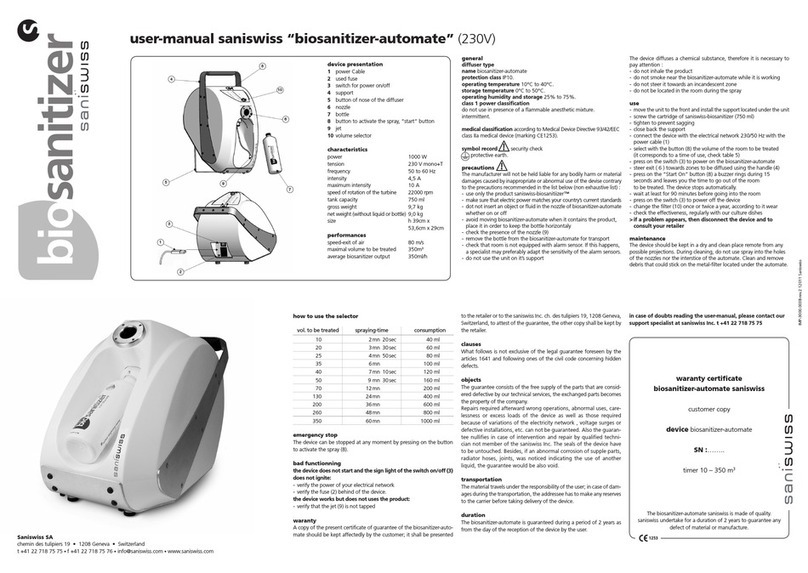
Saniswiss
Saniswiss biosanitizer automate user manual
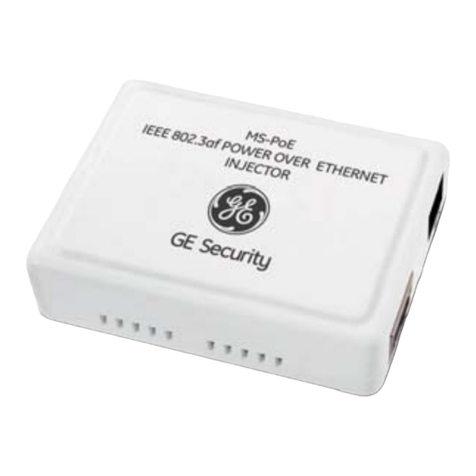
GE
GE MS-PoE user manual
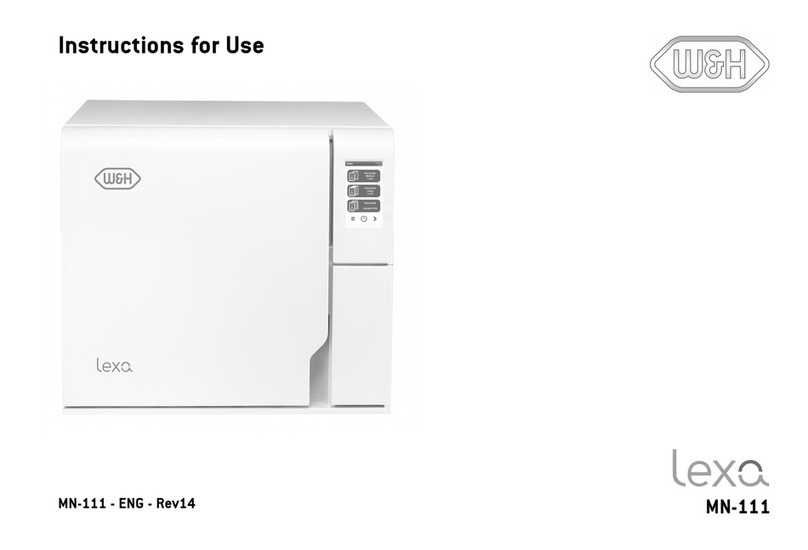
W&H
W&H MN-111 Instructions for use
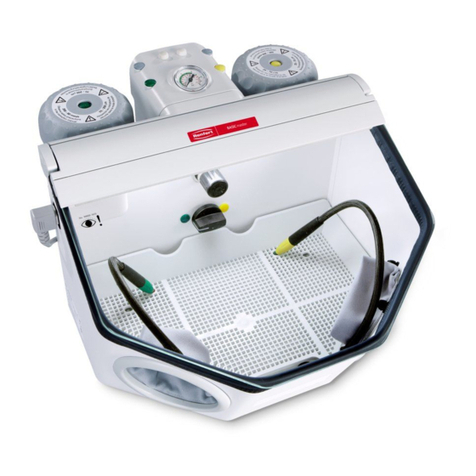
Renfert
Renfert Basic Master Translation of the original instructions for use

REITEL
REITEL RETOMIX COMFORT operating instructions
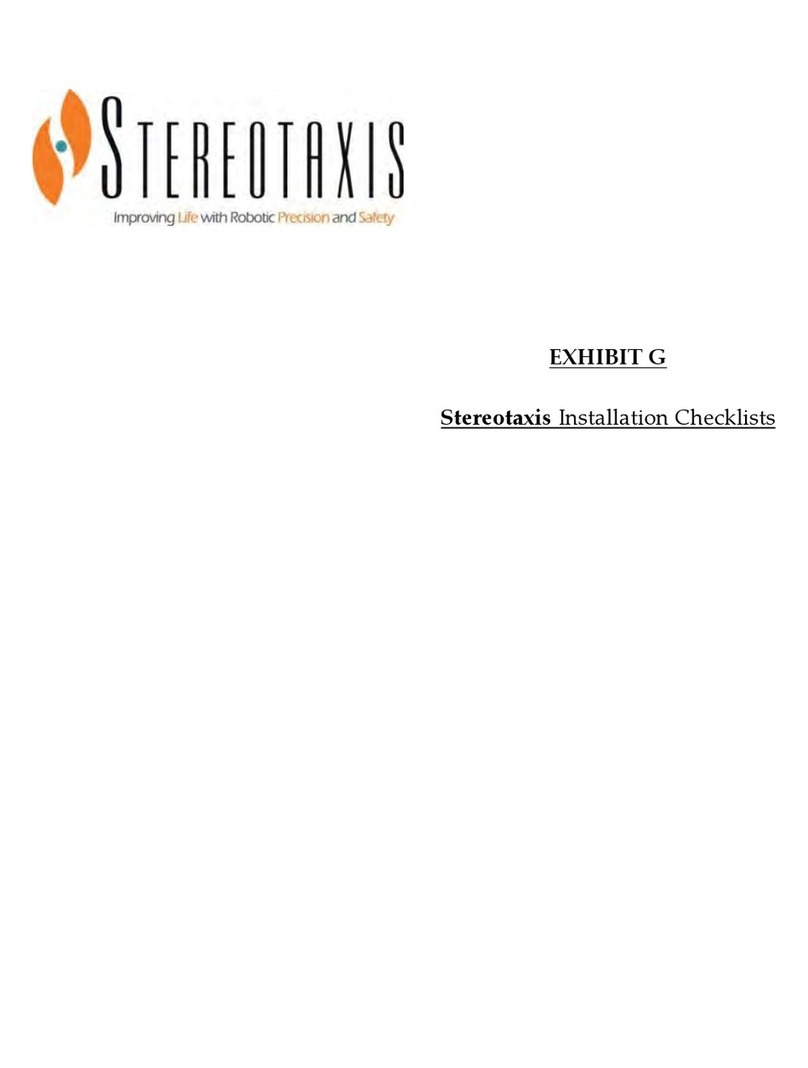
Stereotaxis
Stereotaxis Niobe PM3.1 Installation Verification and Testing
